By Jeffrey A. Rendall, Photos By Jeffrey A. Rendall
DANIELS, WV – Traveling around Glade Springs Resort’s new Stonehaven Course, you can’t help but marvel at its impressive scale, as well as its incredible natural beauty. True to its name, the course offers continuing glimpses of the rocky sub-surfaces that support the golf course and the residential community rapidly growing in around it.
The cart paths wind up, down and around the layout, a journey that’s unforgettable in itself. Stonehaven’s quite a place.
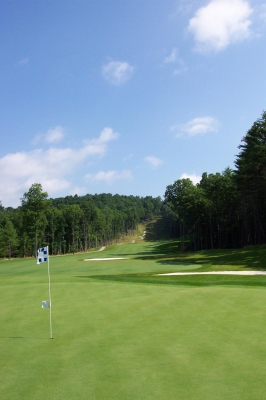 |
| Stonehaven's par five 16th drops like a stone from tee to green, and there's a thrilling cart path ride included. |
For those familiar with how much this type of golf course usually costs to construct, you’re thinking somebody (in this case, Cooper Land Development) must’ve dropped serious bucks to put this facility in here. This type of grandeur doesn’t come cheap… or maybe we should just re-think what we consider ‘expensive.’
“You know, it really didn’t cost that much to build Stonehaven, when you consider the final product,” said Golf Course Architect Tom Clark (of Ault, Clark & Associates), who counts Stonehaven amongst his finest work. “The contractor put in a pretty good bid, and despite all the rock, we really didn’t have to do much dynamiting. It wasn’t easy getting enough topsoil to cover up all the rocks, but basically we laid the course on top of the existing ground, and just got lucky that nature took care of a lot of the rest.”
Okay, so how much was the final tab? ‘Not much’ can mean a lot of things to a lot of people. ‘Not much’ to the Vanderbilt family meant a 50-room summer ‘chateau’ in Newport, Rhode Island.
“What can I say, it was about four and a half million bucks to finish it,” Clark mused.
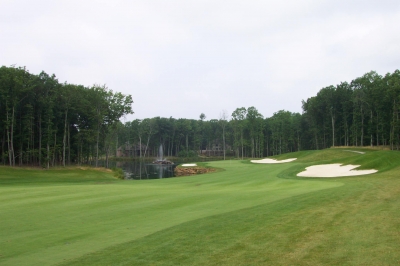 |
| Drama is the word for the par five 4th hole. |
Four and a half million for this? That’s a heck of a good deal. Glade Springs is a bit of a drive for the multitudes of population along the eastern seaboard (about five hours from Washington DC), but together with its sibling The Cobb Course, there’s hardly a better one-two golf punch anywhere than Glade Springs Resort. I’m amazed that you don’t hear more about Glade as a golf destination, but then again, according to Clark and others, the real estate around the course is being snapped up faster than buckwheat pancakes on the first morning of hunting season – so they don’t need to get the word out.
Maybe the homeowners and members prefer to keep it to themselves – and, you can’t really blame them for their selfishness.
Make no mistake, $4.5 million isn’t a trifling amount, by anyone’s measure. But with the price of land these days, along with intrinsic construction costs already built into making a golf course, that’s a pretty darn solid value in today’s market. And to end up with one of the Mid-Atlantic’s finest mountain-style layouts, that’s the deal of the century for the Cooper people and Glade Springs Resort.
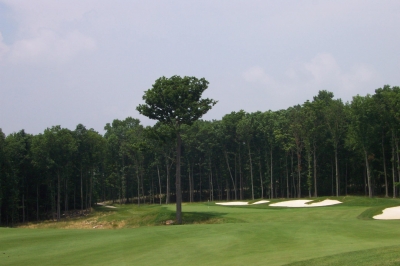 |
| There's a large tree protecting the green on the par four 11th hole. Better be able to maneuver around it. |
It all began a few years back, when Bill Bright of Bright Enterprises acquired Glade Springs Resort, then subsequently struck a deal with Cooper Land Development to develop some of the resort’s 3,500 acres into a golf course community. Cooper’s had a long-standing relationship with the Ault/Clark group, and it certainly made sense for that successful partnership to combine once again in the hills of West Virginia (they’d previously built several award winning golf communities in Arkansas).
Bright also put money into the resort’s facilities, which makes it more attractive for upscale visitors seeking higher-end treatment, such as upgrading the clubhouse and bringing in a chef from The Greenbrier to kick up the cuisine a notch. Bright also improved the hotel accommodations – and while they’re a fair measure more modest than Glade Springs’ previously mentioned West Virginia cousin, so are the prices.
Clark takes the story from here: “In addition to the existing Cobb Course at Glade Springs, there were plans to build another course on the property, way back when (the Cobb Course opened in the early 70’s) – they’d even started clearing it. But that fell through, and the property where the second course would’ve been put is kind of where Stonehaven is now.”
He continues, “We didn’t use any of that routing at all, however. Cobb had routed four starting and finishing holes, and because of the tightness there, we just couldn’t do it that way. So even though you can still service Stonehaven out of the original clubhouse, there wasn’t really any way to have it come back to the clubhouse after nine holes.”
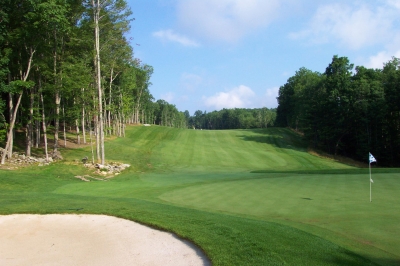 |
| From behind the 9th green -- there're many ups and downs at Stonehaven, but there's still plenty of room side-to-side. |
True, you won’t see the clubhouse again ‘til you’re driving back from the 18th green, but there’s on-course service as well as a snack hut after the 9th hole. Stonehaven’s all-the-way-out, then all-the-way-back routing gives it even more of a rugged adventurous feel to it, which is perfect for this part of the country. And trust me, you won’t starve.
Not only will you not feel any pangs of hunger, you’ll be thrilled by turning every corner at Stonehaven – because each hole is a new adventure that you haven’t seen before. From the back sets of tees, there are a number of ravines to carry, but the landing areas are exceptionally wide. It’s one of those courses that looks pretty daunting, but plays quite passively.
Rob Seiter, Stonehaven’s Golf Course Superintendent, says it’s a very friendly course to play – and he should know, since he takes great care of every inch of it: “As long as you’re playing from the right set of tees, this course won’t hurt you very much. High handicappers tend to want to challenge themselves and think about playing from the blue tees (6,678 yards, with the black tees measuring 7,203), but with all the carries over the environmental areas, you can get in trouble fast if you can’t fly it at least 200 yards.”
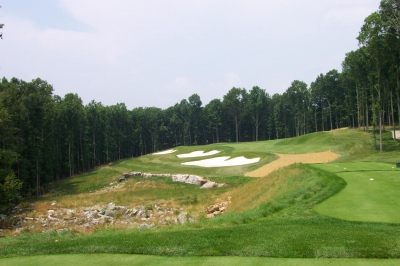 |
| The par three 12th hole is Stonehaven's shortest, but the green won't make it play any easier. |
That’s not all, as Seiter tells it: “The greens do have some big tiers in them, but I think they’re fairly easy to putt – no tricked up greens out here. You’ve got some major transitions in them, which kind of split the greens in half, but a lot of the pin positions are designed to have the ball filter down towards the hole.”
There’s also mowed chipping areas around most of the greens, which helps in the short-game. Long, thick rough is prevalent throughout the region, but Stonehaven’s got a bit of a different (and more-friendly) philosophy.
Playing Stonehaven and getting to talk with Seiter as his crew got the course ready one morning was impressive. It was an eye-opening experience seeing just how much goes into maintaining first-rate conditions on a golf course. Seiter acknowledges that Stonehaven is very new and needs to mature, but despite a few drainage issues, the playing surfaces are in great shape for a course so new (it opened in July of 2003).
Seiter’s modesty won’t allow him to take credit, claiming there’s still much to be done, and is more than willing to heap praise on his crew – the guys out there mowing the grass and raking the sand. He says there’s been a marked improvement in the staff’s work and attitude since last year, and the results are showing in lush green grass. Seiter came to Glade Springs from The Greenbrier, so he too knows his business.
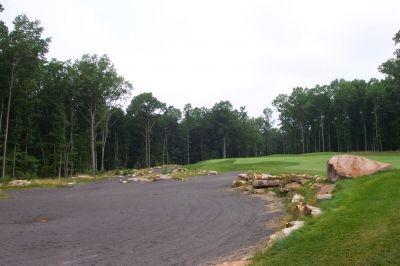 |
| That 'washed sand' in the waste bunkers gives Stonehaven a distinctive look, and is also very playable. |
As if the rock outcroppings weren’t enough, Stonehaven offers some unique bunker material that you won’t see anywhere else. It’s kind of grayish-black in color, but plays just as well as the best bunker sand.
Seiter explains what it is: “They call it ‘washed sand,’ and it comes from one of the local gravel quarries. When they make a certain type of gravel, when they’re making road cinders, they only wash the product once – and they don’t use the waste product from that washing. They then ended up making a type of gravel that goes through the washing process twice, and our ‘washed sand’ is essentially the waste material from that process.”
“It provides for a nice contrast to the golf course, and it’s very original to Stonehaven. Further than that, it’s easy to maintain – we use it for waste bunkers, and we only need to rake it every week or so,” Seiter added.
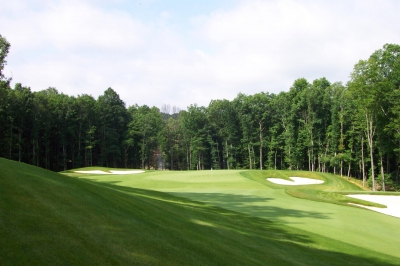 |
| The par three 17th hole. Make sure you've got yardage to the pin from the tee -- or a three-putt is likely. |
Note – there are ‘traditional’ bunkers as well, with ‘real’ sand at Stonehaven.
Perhaps even more memorable than the ‘washed sand’ waste bunkers is the rock. “We used a lot of what we call ‘rock gardens,’” Clark explained. “There was just so much rock up there, so we incorporated some of it into the design and strategy. We’d leave it exposed in places, and plant wildflowers and fescue to accent it. The rock adds a really distinctive look.”
You’ll see it on Stonehaven’s signature par three, the sixth hole, on the left side of the par five tenth, near the green on the left side of eleven, the whole left side of the par three twelfth… all over the place. There are also stacked rock walls fronting ponds and greens on several holes.
“One of the things I love about Stonehaven – it has four of the best par fives and four of the best par threes you’ll find anywhere,” Clark said. The rock on those holes helps make them memorable, and Clark’s right, there’s quite a collection of three’s and five’s (the par fours aren’t bad either).
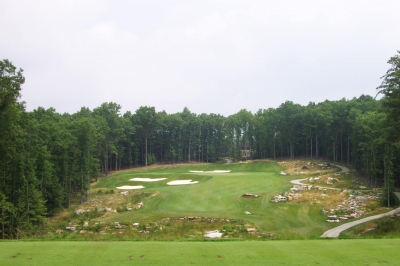 |
| Stonehaven's signature par three 6th hole. Rock Gardens, with a little golf mixed in. |
Stonehaven’s highlights include the fourth hole, the first par five on the course. The view from the tee is breathtaking, as you’re teeing over a ravine to a very wide landing area – but keep the ball to the right, or it may roll through the fairway on the left. The second and potential third shots are to a green fronted by one of those stone walls, with a lake (and fountain) to the left. Wow.
The 221-yard, par three sixth hole is probably the one you’ll remember most from Stonehaven, as it’s got the most extensive rock gardens. It’s a tough hole, too, as the green’s slightly above you off the tee (at least from the forwards sets of tees), and anything short of the green will hit a false front and roll all the way back down.
The entire back nine is a series of highlight holes, starting with ten and ending with eighteen. But one stands out from the rest – the par five sixteenth hole. Just reaching the tee is a memorable event, as you’ve just traveled down a cart path with switch-backs to get there. Needless to say, the view stays with you once you’re down on the flatter part. Tremendous hole.
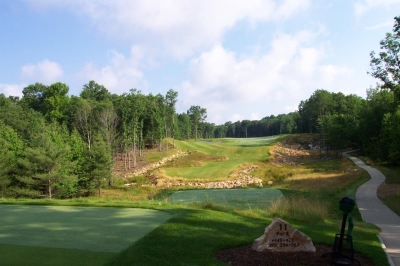 |
| A view you'll see from many of the tee boxes -- a carry to the landing area, but plenty of room once you get there. Here, the 11th tee. |
The experience of playing Stonehaven is simply one of the best in the Mid-Atlantic. The service level at Glade Springs probably doesn’t reach that of the region’s super-luxury golf resorts, but its golf product certainly belongs on equal footing with any of them.
And you won’t believe how little they spent to build it.
Glade Springs Resort – Golf, and Much More
Family-friendly Glade Springs Resort is an outdoor oriented destination, with a multitude of activities to choose from before, after, or even instead of golf (okay, maybe not instead of). The resort offers a full-service equestrian center, a pool, Spa, tennis courts, hiking trails and horseback riding trails, as well as two restaurants for your culinary needs.
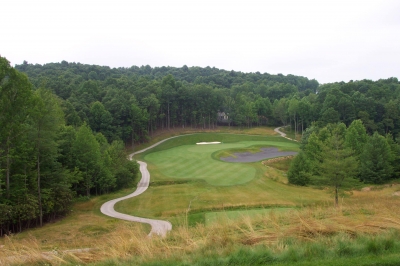 |
| The par three 2nd hole. Looks hard, but is actually very playable. Stonehaven defined. |
For the outdoorsman in you, there’s fly-fishing, casting classes, whitewater rafting, and target shooting. Snow skiing is nearby for the winter months. The golf courses remain open year-round, snow cover permitting.
Sleeping accommodations range from one bedroom suites to six bedroom lodges – bring your group of up to forty, and you’ll find space for them. Consult the website at http://www.gladesprings.com for more details, as well as contact and booking information.
Again, Glade Springs offers well accented accommodations and facilities, perhaps a notch below The Greenbrier and The Homestead – but a stay there won’t come nearly as dear, either.
Details:
Stonehaven Golf Course at Glade Springs
Phone: (866) 704-3071; (304) 763-2000
FAX: (304) 763-3398
Website: www.gladesprings.com?NCK=golfthemidatlantic
Course Designer: Tom Clark
Golf Course Superintendent: Rob Seiter
Tees/Yardage
Black 7203
Blue 6678
White 6215
Yellow 5593
Red 5114
Rates:
Stonehaven
Weekday $75.00 plus tax
Weekend $85.00 plus tax
Member Guest $55.12
Resort Guest $63.81
Cooper Land Development Guest $55.12
Cobb Course
Weekday $69.00 plus tax
Weekend $79.00 plus tax
Member Guest $53.00
Resort Guest $62.54
Walking is allowed, but if there’s one course that realistically isn’t walkable, it’s Stonehaven. It’s not just the slopes, it’s the distance between greens and tees.
Additional fee for range privileges.
| Related Links | Comments on this article? | |
|
Maryland National Golf Club Hollow Creek Golf Club Rocky Gap Resort PB Dye Golf Club in Ijamsville Whiskey Creek Golf Club |
E-mail Jeff Rendall, Editor: jrendall@golftheunitedstates.com |












